Assessment of Carbon Reduction Benefits of A/O-Gradient Constructed Wetland Renovation for Rural Wastewater Treatment in the Southeast Coastal Areas of China Based on Life Cycle Assessment: The Example of Xiamen Sanxiushan Village
Abstract
:1. Introduction
2. Materials and Methods
2.1. System Boundary
2.2. Function Unit
2.3. Calculation Method
2.3.1. Basic Calculation Methods for GHG Emissions and Carbon Storge
- Basic calculation method of GHG emissions
- 2.
- Basic calculation method of carbon storge
2.3.2. GHG Emissions and Carbon Storge Impact Assessment
- GHG emissions impact during the construction stage.
- 2.
- GHG emissions and carbon storge impacts during the use stage
- GHG emissions in the use stage were calculated using the following formula.
| Content | Name | Unit | GHG Emissions Factors (kgCO2eq/Unit) | GHG Emission Sources | |
|---|---|---|---|---|---|
| Wastewater treatment station operation | Wastewater Treatment | Wastewater Treatment CH4 Discharge | KgCO2eq/kgCOD | 0.25 | wastewater treatment process |
| Wastewater Treatment N2O Discharge | KgCO2eq/kgN | 0.005 | |||
| Equipment operation in an integrated wastewater treatment plant | KgCO2eq/Kw | 0.8086 | equipment operation energy | ||
| wastewater treatment agents consumption | PAM | KgCO2eq/kg | 1.5 kg | wastewater treatment agents production | |
| PAC | KgCO2eq/kg | 1.6 kg | |||
| NaClO | KgCO2eq/kg | 1.4 kg | |||
| Landscaping Maintenance | Fertilizing | Nitrogen fertilizer (urea) | KgCO2eq/kg N | 2.041 | fertilizer production |
| Irrigation | Water pumping | KgCO2eq/Kw | 0.8086 | Equipment operation energy | |
- The formula for calculating the carbon storge in the use stage is
- 3.
- GHG emissions impact during the dismantling stage
2.4. Evaluation Indicators
2.4.1. Carbon Payback Time Assessment (CPBT)
2.4.2. Carbon Reduction Efficiency
3. Case Studies
3.1. Case Selection
3.2. Accounting for GHG Emissions in Retrofit Projects
3.2.1. Inventory of GHG Emissions and Carbon Storge of Retrofit Projects
3.2.2. Data Sources
- Construction and demolition stages
- 2.
- Use stage
4. Results
4.1. Whole Life-Cycle Carbon Impact and Carbon Reduction Benefits
4.1.1. Carbon Reduction Impact of the Use Stage before and after Retrofitting
4.1.2. Post-Retrofit Dismantling Stage
4.2. Carbon Payback Time (CPBT)
4.3. Carbon Reduction Efficiency
5. Discussion
- Reduction in implied GHG emissions
- 2.
- Enhancement of carbon storge in terraced Constructed wetlands and their landscape greenery
6. Conclusions
- This research introduces an approach for assessing the impact of GHG emissions and carbon mitigation advantages stemming from the refurbishment of rural wastewater treatment facilities in southeastern coastal regions of China. The approach encompasses three stages: construction, utilization, and demolition, and involves two wastewater treatment systems: wastewater treatment stations and constructed wetlands. The investigators examined the renovation of a wastewater treatment facility in Sanxiushan Village, Xiamen City, Fujian Province, employing the “integrated equipment treatment technology—Constructed wetland” system. The primary findings are derived from computations using this case study.
- The impact of implied GHG emissions is substantial. Based on the calculated results, carbon reduction efficacy is overestimated by 28.18% (from 37.60% to 9.42%) when overlooking implicit GHG emissions. This indicates that the construction stage of the retrofitting process significantly impacts the carbon reduction outcome. Furthermore, if construction materials are entirely recycled and repurposed during the demolition stage, GHG emissions can be effectively decreased (from 12,226.60 kgCO2eq to 4340.57 kgCO2eq). Luo Xiaoyu et al. (2022) [72] demonstrated that GHG emissions during the demolition stage can be negative if full recycling of building materials is taken into account [88].
- Despite considering the effect of implicit GHG emissions, the transformation is advantageous. The optimal carbon recovery duration for the case study project was 18.97 years, with the carbon recovery period for the terraced constructed wetlands and their landscape greenery being only 2.82 years. The shorter the carbon recovery period, the greater the carbon reduction benefits in the usage stage post-renovation. Consequently, in similar projects, expanding the area of landscape greenery, carefully selecting tree species, and optimizing vegetation community structure can effectively diminish the GHG emissions throughout the entire life cycle of the “integrated equipment treatment technology—constructed wetland”.
Author Contributions
Funding
Institutional Review Board Statement
Informed Consent Statement
Data Availability Statement
Conflicts of Interest
References
- Panja, P. Deforestation, Carbon dioxide increase in the atmosphere and global warming: A modelling study. Int. J. Model. Simul. 2019, 41, 209–219. [Google Scholar] [CrossRef]
- Liu, Z.M.; Zhang, Y. Temporal and spatial transition characteristics, influencing factors and peak path design of carbon emissions in China. J. Southwest Univ. Soc. Sci. 2022, 48, 99–112. [Google Scholar]
- Dai, S.; Qian, Y.; He, W.; Wang, C.; Shi, T. The spatial spillover effect of China’s carbon emissions trading policy on industrial carbon intensity: Evidence from a spatial difference-in-difference method. Struct. Change Econ. D 2022, 63. [Google Scholar] [CrossRef]
- The People’s Republic of China First Biennial Update Report on Climate Change. Available online: https://www.mee.gov.cn/ywgz/ydqhbh/wsqtkz/201904/P020190419522735276116.pdf (accessed on 15 February 2023).
- Lu, J.Y. Carbon Footprint and Reduction Potential of Chinese Waste Water Treatment Sector. Master’s Thesis, University of Science and Technology of China, Hefei, China, 2019. [Google Scholar]
- Gardner, E.A.; Morton, D.; Sands, J.; Matthews, P.; Cook, F.; Jayawardane, N.S. The filter system for tertiary treatment of sewage effluent by land application—Its performance in a subtropical environment. Water Sci. Technol. 2001, 43, 335–342. [Google Scholar] [CrossRef] [PubMed]
- Li, Y.T.; Shi, Y.M.; Wang, J. Research progress on integrated treatment technologies of rural domestic sewage. J. Environ. Eng. Technol. 2021, 11, 499–506. [Google Scholar]
- Zhu, Y.G.; Yang, J.; Qiao, M.M. Project case of domestic sewage treatment by buried integrated AO contact oxidation technology. Technol. Water Treat. 2017, 43, 134–138. [Google Scholar]
- Technical Requirements of Operation Performance Assessment for Rural and Small Town Sewage Treatment Facilities. Available online: https://www.cnis.ac.cn/bydt/bzyjzq/gbyjzq/201909/P020190926570333354570.pdf (accessed on 15 February 2023).
- Announcement, No. 1, 2021: Tracking Audit Results of the Implementation of Major National Policies and Measures in the Third Quarter of 2020 Website of the National Audit Office. Available online: https://www.audit.gov.cn/n5/n25/c142989/content.html (accessed on 8 April 2023).
- Notice of the National Development and Reform Commission of the Ministry of Housing and Urban-Rural Development on Issuing the Implementation Plan for Carbon Peaking in Urban and Rural Construction Urban and Rural Construction (including Housing) Gov.cn. Available online: http://www.gov.cn/zhengce/zhengceku/2022-07/13/content_5700752.htm (accessed on 8 April 2023).
- Li, W.; Zhou, Y.; Dai, X.; Hu, F. Evaluation of rural tourism landscape resources in terms of carbon neutrality and rural revitalization. Sustainability 2022, 14, 2863. [Google Scholar] [CrossRef]
- She, Y.J. Research on Infrastructure Investment Portfolio of Mountainous Townships in Southwest China in the Perspective of Sustainable Construction. Ph.D. Dissertation, Chongqing University, Chongqing, China, 2018. [Google Scholar]
- Zhang, Y.; Ge, T.; Liu, J.; Sun, Y.; Liu, Y.; Zhao, Q.; Tian, T. The comprehensive measurement method of energy conservation and emission reduction in the whole process of urban sewage treatment based on carbon emission. Environ. Sci. Pollut. R 2021, 8, 56727–56740. [Google Scholar] [CrossRef] [PubMed]
- Liu, L.; Zhang, X.; Lyu, Y. Performance comparison of sewage treatment plants before and after their upgradation using emergy evaluation combined with economic analysis: A case from Southwest China. Ecol. Model. 2022, 472, 110077. [Google Scholar] [CrossRef]
- Zhang, X.; Wang, F. Analysis of embodied carbon in the building life cycle considering the temporal perspectives of emissions: A case study in China. Energy Build. 2017, 155, 404–413. [Google Scholar] [CrossRef]
- Zhang, X.; Liu, K.; Zhang, Z. Life cycle carbon emissions of two residential buildings in China: Comparison and uncertainty analysis of different assessment methods. J. Clean. Prod. 2020, 266, 122037. [Google Scholar] [CrossRef]
- Pham, A.; Moussavi, S.; Thompson, M.; Dvorak, B. Environmental life cycle impacts of small wastewater treatment plants: Design recommendations for impact mitigation. Water Res. 2021, 207, 117758. [Google Scholar] [CrossRef] [PubMed]
- Remy, C.; Lesjean, B.; Waschnewski, J. Identifying energy and carbon footprint optimization potentials of a sludge treatment line with Life Cycle Assessment. Water Sci. Technol. 2013, 67, 63–73. [Google Scholar] [CrossRef] [PubMed]
- Liu, B.; Wei, Q.; Zhang, B.; Bi, J. Life cycle GHG emissions of sewage sludge treatment and disposal options in Tai Lake Watershed, China. Sci. Total Environ. 2013, 447, 361–369. [Google Scholar] [CrossRef] [PubMed]
- Lehtoranta, S.; Vilpas, R.; Mattila, T.J. Comparison of carbon footprints and eutrophication impacts of rural on-site wastewater treatment plants in Finland. J. Clean Prod. 2014, 65, 439–446. [Google Scholar] [CrossRef]
- Laura, F.; Joan, G.; Rocío, P.; Marianna, G. Constructed wetlands for winery wastewater treatment: A comparative Life Cycle Assessment. Sci. Total Environ. 2019, 659. [Google Scholar]
- Valerie, J.F.; James, R.M.; John, S.G. Life cycle assessment of vertical and horizontal flow constructed wetlands for wastewater treatment considering nitrogen and carbon greenhouse gas emissions. Water Res. 2010, 45, 2073–2081. [Google Scholar]
- Li, F. Analysis of energy situation in China’s building materials industry. Jiangsu Build. Mater. 2007, 4, 59–60. [Google Scholar] [CrossRef]
- AR6 Synthesis Report: Climate Change 2023. Available online: https://www.ipcc.ch/report/ar6/syr/ (accessed on 8 April 2023).
- Ma, N.; He, X.; Shi, X.; Chen, W. Assessment of urban forest economic benefits based on i-Tree model: Research progress. Chin. J. Ecol. 2011, 30, 810–817. [Google Scholar]
- Wang, Q.; Zhang, Z.; Wang, P. An assessment of ecosystem services of urban green spaces based on i-Tree. J. Landsc. Res. 2019, 11, 53–56. [Google Scholar]
- Wu, J.; Wang, Y.; Qiu, S.; Peng, J. Using the modified i-Tree Eco model to quantify air pollution removal by urban vegetation. Sci. Total Environ. 2019, 688, 673–683. [Google Scholar] [CrossRef] [PubMed]
- Nowak, D.J. Atmospheric carbon reduction by urban trees. J. Environ. Manag. 1993, 37, 207–217. [Google Scholar] [CrossRef]
- Tree. i-Tree Eco User’s Manual. Available online: https://www.itreetools.org/documents/275/EcoV6_UsersManual.2021.09.22.pdf (accessed on 28 April 2023).
- GBT 51366-2019; Standards for Calculating Carbon Emissions from Buildings. Ministry of Housing and Urban-Rural Development of China: Beijing, China, 2019; Volume 2023.
- Ministry of Ecology and Environment. China Regional Power Grid Baseline Emission Factor for 2019 Emission Reduction Project; Ministry of Ecology and Environment of the People’s Republic of China: Beijing, China, 2023.
- Dong, K. Study on the Building Carbon Dioxide Emissions Based Onrein Forced Concretestructures. Master’s Dissertation, Qingdao Technological University, Qingdao, China, 2011. [Google Scholar]
- Na, L. Research on Carbon Emission Calculation and Emission Reduction Strategies of Building Based on Life Cycle Assessment. Master’s Dissertation, Shijiazhuang Tiedao University, Shijiazhuang, China, 2014. [Google Scholar]
- Liu, R.J.; Zhang, Z.H.; Zhou, L. Comparative study on Environmental effects of waterproofing materials during life cycle. Environ. Pollut. Control. 2011, 33, 103–106. [Google Scholar]
- Cang, Y.J. Study on Accounting Methods of Building Carbon Emission in Embodied Stage. Master’s Dissertation, Xi’an University of Architecture and Technology, Xi’an, China, 2018. [Google Scholar]
- Huang, L.Q.; Zhang, Y.; Deng, Y.R.; Ling, L.L.; Liu, X.Z.; Xiao, R.B. The carbon footprint accounting and assessment of urban green space-taking Guangzhou as an example. For. Resour. Manag. 2017, 9, 65–73. [Google Scholar]
- Li, C.J.; Jia, P.Y.; Dong, L. Preliminary study on the near nature garden plant community and its evaluation index system. In Proceedings of the 2007 Annual Meeting of Ornamental Horticulture Committee of Chinese Society of Horticulture, Baoding, China, 9 August 2007; p. 3. [Google Scholar]
- IPCC/OECD. Ipcc Draft Guidelines for National Greenhouse Gas Inventories; Intergovernmental Panel on Climate Change/Organisation for Economic Co-operation and Development Joint Programme; IPCC: Geneva, Switzerland; OECD: Paris, France, 1994; p. 364. [Google Scholar]
- Chen, S.; Lu, F.; Wang, X.K. Estimation of greenhouse gases emission factors for China′s nitrogen, phosphate, and potash fertilizers. Acta Ecol. Sin. 2015, 35, 6371–6383. [Google Scholar]
- Luo, B.; Du, Y.; Han, W.; Geng, Y.; Wang, Q.; Duan, Y.; Ren, Y.; Liu, D.; Chang, J.; Ge, Y. Reduce health damage cost of greenhouse gas and ammonia emissions by assembling plant diversity in floating constructed wetlands treating wastewater. J. Clean. Prod. 2020, 244, 118927. [Google Scholar] [CrossRef]
- Zhang, S.; Liu, F.; Luo, P.; Xiao, R.; Zhu, H.; Wu, J. Nitrous oxide emissions from pilot scale three-stage con-structed wetlands with variable nitrogen loading. Bioresour. Technol. 2019, 289, 121687. [Google Scholar] [CrossRef]
- Hao, X.; Meng, X.; Hu, R. Emissions, influence and control of greenhouse gases in constructed wetlands. China Water Wastewater 2016, 32, 39–47. [Google Scholar]
- Publications—IPCC-TFI. Available online: https://www.ipcc-nggip.iges.or.jp/public/wetlands/ (accessed on 16 February 2023).
- Salm, J.-O.; Maddison, M.; Tammik, S.; Soosaar, K.; Truu, J.; Mander, Ü. Emissions of CO2, CH4 and N2O from undisturbed, drained and mined peatlands in Estonia. Hydrobiologia 2012, 692, 41–55. [Google Scholar] [CrossRef]
- Soosaar, K.; Mander, Ü.; Maddison, M.; Kanal, A.; Kull, A.; Lõhmus, K.; Truu, J.; Augustin, J. Dynamics of gaseous nitrogen and carbon fluxes in riparian alder forests. Ecol. Eng. 2010, 37, 40–53. [Google Scholar] [CrossRef]
- Wu, J.; Zhang, J.; Jia, W.; Xie, H.; Zhang, B. Relationships of nitrous oxide fluxes with water quality parameters in free water surface constructed wetlands. Front. Environ. Sci. Eng. China 2009, 3, 241–247. [Google Scholar] [CrossRef]
- Lu, S.; Li, K.; Jia, J.; Wan, Z.; Wang, G.; Liu, P. Phosphorus removal efficiency of simulated series vertical flow constructed wetlands treating river water. Res. Environ. Sci. 2016, 29, 1218–1223. [Google Scholar]
- Supplement to the 2006 IPCC Guidelines for National Greenhouse Gas Inventories: Wetlands—IPCC. Available online: https://www.ipcc.ch/publication/2013-supplement-to-the-2006-ipcc-guidelines-for-national-greenhouse-gas-inventories-wetlands/ (accessed on 29 March 2023).
- Michael, A.; Joseph, P.M.; David, J.N.; Dar, A.R. Mapping urban forest structure and function using hyperspectral imagery and lidar data. Urban For. Urban Green. 2016, 17, 135–147. [Google Scholar]
- Boukili, V.K.; Bebber, D.P.; Mortimer, T.; Venicx, G.; Lefcourt, D.; Chandler, M.; Eisenberg, C. Assessing the performance of urban forest carbon sequestration models using direct measurements of tree growth. Urban For. Urban Green. 2017, 24, 212–221. [Google Scholar] [CrossRef]
- Wu, W.T.; Xia, G.Y.; Bao, Z.Y. The assessment of the carbon fixation and oxygen release value of the urban green space in Hangzhou. Chin. Landsc. Archit. 2016, 32, 117–121. [Google Scholar]
- Wang, Y.Q. Assessment of Function and Valuation about the Ecosystem Services Provided by Urban Forest in Xiamen. Master’s Dissertation, Fujian Agriculture and Forestry University, Fuzhou, China, 2011. [Google Scholar]
- Li, X.B. Carbon Sequestration of Urban forestsand Lawns in Fuzhou City. Ph.D. Dissertation, Fujian Normal University, Fuzhou, China, 2012. [Google Scholar]
- Xin, C. Studies on Influencing Factors and Reduction Measure of Greenhouse Gas Emissions in Constructed Wetland Wastewater Treatment Systems. Master’s Dissertation, Northeast Institute of Geography and Agroecology, University of Chinese Academy of Sciences, Beijing, China, 2020. [Google Scholar]
- Xu, H.T.; Wang, L.Q.; Shen, J.; Ji, G.H.; Zhao, F.B. Plant and soil organic carbon pools in a constructed wetland of Shatianhu River. Chin. J. Ecol. 2011, 30, 1083–1090. [Google Scholar]
- Zhang, K.; Li, Y.Y. Comparative analysis of carbon emission in the whole life cycle of high-rise reinforced concrete residential buildings in China. Urban. Archit. 2020, 17, 36–38. [Google Scholar]
- Ying, J.; Yi, C. Research on the building carbon emission calculation method in compliance with the theory of full lifecycle—Based upon statistical analysis of CNKI’s domestic literature dated between 1997–2013. Hous. Sci. 2014, 34, 32–37. [Google Scholar]
- Xu, J.; Shi, Y.; Xie, Y.; Zhao, S. A BIM-based construction and demolition waste information management system for greenhouse gas quantification and reduction. J. Clean. Prod. 2019, 229, 308–324. [Google Scholar] [CrossRef]
- Gao, C.K.; Chen, S.; Chen, S.; Wang, S.C. Life cycle assessment of integrated iron and steel works in China. J. Harbin Inst. Technol. 2016, 48, 177–181. [Google Scholar]
- Bok, Y.J.; Tae, S.H.; Kim, R.Y. Analysis of CO2 Emission in the Waste Disposal Process Based on Computation of Construction Waste. In Advanced Materials Research; Trans Tech Publications Ltd.: Incheon, Republic of Korea, 2014; Volume 1025, pp. 1079–1082. [Google Scholar] [CrossRef]
- Asdrubali, F.; Ballarini, I.; Corrado, V.; Evangelisti, L.; Grazieschi, G.; Guattari, C. Energy and environmental payback times for an NZEB retrofit. Build Environ. 2019, 147, 461–472. [Google Scholar] [CrossRef]
- Heaven, S.; Salter, A.; Clarke, D. Influence of annual climate variability on design and operation of waste stabilisation ponds for continental climates. Water Sci. Technol. 2007, 55, 37–46. [Google Scholar] [CrossRef] [PubMed]
- Yuan, Z.S. Operation Parameter Optimization of Combined Process of A/O-Constructed Wetland and Screening of Plants for the Treatment of Rural Waste Water. Master’s Dissertation, Nanjing Agricultural University, Nanjing, China, 2014. [Google Scholar]
- Hu, X.B.; Luo, H.; Jin, Z.Q.; Zhang, Z.Y. Research progress of rural domestic sewage treatment technology. Appl. Chem. Ind. 2020, 49, 2871–2876. [Google Scholar]
- Carsten, S.; Jörg, G.; Bernhard, R. Treatment of rainbow trout farm effluents in constructed wetland with emergent plants and subsurface horizontal water flow. Aquaculture 2003, 217, 207–221. [Google Scholar]
- Kuschk, P.; Wiessner, A.; Kappelmeyer, U.; Weissbrodt, E.; Kästner, M.; Stottmeister, U. Annual cycle of nitrogen removal by a pilot-scale subsurface horizontal flow in a constructed wetland under moderate climate. Water Res. 2003, 37. [Google Scholar] [CrossRef] [PubMed]
- Shen, L.Y.; Wu, J.; Zhong, F.; Xiang, D.F.; Chen, S.P. Effect of step feeding on the performance of multi-stage vertical flow constructed wetland for municipal wastewater treatment. J. Lake Sci. 2017, 29, 1084–1090. [Google Scholar] [CrossRef]
- Zhong, Q.S.; Sun, X.W.; Wang, J.Y.; Chen, J. Multilevel waterfall-organic filler constructed wetland for rural domestic sewage treatment. Environ. Eng. 2014, 32, 18–22. [Google Scholar]
- Hossain, M.U.; Wu, Z.; Poon, C.S. Comparative environmental evaluation of construction waste management through different waste sorting systems in Hong Kong. Waste Manag. 2017, 69, 325–335. [Google Scholar] [CrossRef]
- Liu, Y.D. Research of Comprehensive Benefit Evaluation and Strategic Choice of Construction Waste Disposal. Master’s Dissertation, Guangzhou University, Guangzhou, China, 2020. [Google Scholar]
- Luo, X.; Ren, M.; Zhao, J.; Wang, Z.; Ge, J.; Gao, W. Life cycle assessment for carbon emission impact analysis for the renovation of old residential areas. J. Clean. Prod. 2022, 367, 132930. [Google Scholar] [CrossRef]
- Mitchell, J.T.; Grace, J.; Harrison, G.P. CO2 payback time for a wind farm on afforested peatland in the UK. Mires Peat 2010, 4, 10. [Google Scholar]
- Li, R.; Zhang, H.; Wang, H.; Tu, Q.; Wang, X. Integrated hybrid life cycle assessment and contribution analysis for CO2 emission and energy consumption of a concentrated solar power plant in China. Energy 2019, 174, 310–322. [Google Scholar] [CrossRef]
- Ke, L. Study on Low Carbon Design of High and Large Space Public Building in Hot Summer and Cold Winter Area of China. Ph.D. Dissertation, Southeast University, Cape Girardeau, MO, USA, 2021. [Google Scholar]
- Al, P.C.E. Low-Carbon Buildings and Low-Carbon Cities; China Environmental Publishing Group: Beijing, China, 2018. [Google Scholar]
- Yang, K.H.; Song, J.K.; Song, K.I. Assessment of CO2 reduction of alkali-activated concrete. J. Clean. Prod. 2013, 39, 265–272. [Google Scholar] [CrossRef]
- Xu, G.; Li, Y.; Hou, W.; Wang, S.; Kong, F. Effects of substrate type on enhancing pollutant removal performance and reducing greenhouse gas emission in vertical subsurface flow constructed wetland. J. Environ. Manag. 2020, 280, 111674. [Google Scholar] [CrossRef] [PubMed]
- Zhao, Z.J.; Hao, Q.J.; Tu, T.T.; Hu, M.L.; Zhang, X.Y.; Jiang, C.S. Effects of Ferric-Carbon Micro-Electrolysis and Zeolite on Water Purification and Green House Gas Emissions of Aeration Constructed Wetland. Master’s Dissertation, Southwest University, Cape Girardeau, MO, USA, 2021. [Google Scholar]
- Xu, G.M. Effect of Sub Strate Configuration on Constructed Wetland Performance and Greenhouse Gas Flux. Master’s Dissertation, Qingdao University, Qingdao, China, 2020. [Google Scholar]
- Jiao, D. Research of the Selection and Decision Model of Construction Equipment under Carbon Constraints. Master’s Dissertation, Dalian University of Technology, Dalian, China, 2011. [Google Scholar]
- Escobedo, F.; Varela, S.; Zhao, M.; Wagner, J.E.; Zipperer, W. Analyzing the efficacy of subtropical urban forests in offsetting carbon emissions from cities. Environ. Sci. Policy 2010, 13, 362–372. [Google Scholar] [CrossRef]
- Wang, Y.; Chang, Q.; Li, X. Promoting sustainable carbon sequestration of plants in urban greenspace by planting design: A case study in parks of Beijing. Urban For. Urban Green. 2021, 64, 127291. [Google Scholar] [CrossRef]
- Brix, H.; Sorrell, B.K.; Lorenzen, B. Are phragmites-dominated wetlands a net source or net sink of greenhouse gases? Aquat. Bot. 2001, 69, 313–324. [Google Scholar] [CrossRef]
- Sorrell, B.K.; Brix, H.; Schierup, H.H.; Lorenzen, B. Die-back of phragmites australis: Influence on the distribution and rate of sediment methanogenesis. Biogeochemistry 1997, 36, 173–188. [Google Scholar] [CrossRef]
- Chen, H.; Zhou, S.; Wu, N.; Wang, Y.F.; Luo, P.; Shi, F.S. Advance in studies on production, oxidation and emission flux of methane from wetlands. Chin. J. Appl. Environ. Biol. 2006, 12, 726–733. [Google Scholar]
- Huang, G.H.; Xiao, D.N.; Li, Y.X.; Chen, G.X.; Yang, Y.C.; Zhao, C.W. CH4 emissions from the reed wetland. Acta Ecol. Sin. 2001, 21, 1494–1497. [Google Scholar]
- Wang, W.Q.; Zeng, C.S.; Tong, C. Reviews on the mechanism of methane emission and methane flux in reed (Phragmites australis) marsh. Agric. Syst. Sci. Compr. Study 2008, 24, 20–25. [Google Scholar]
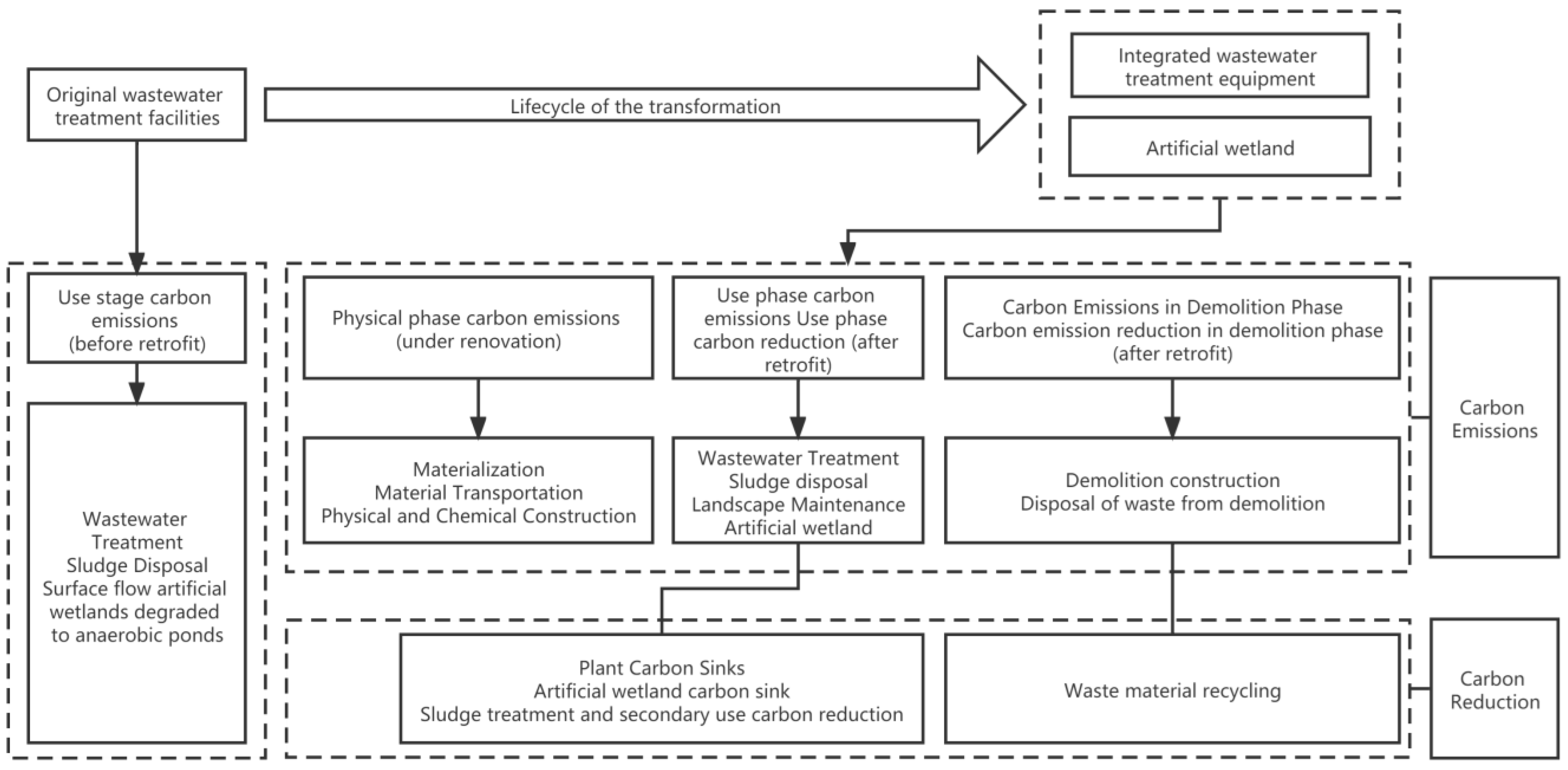
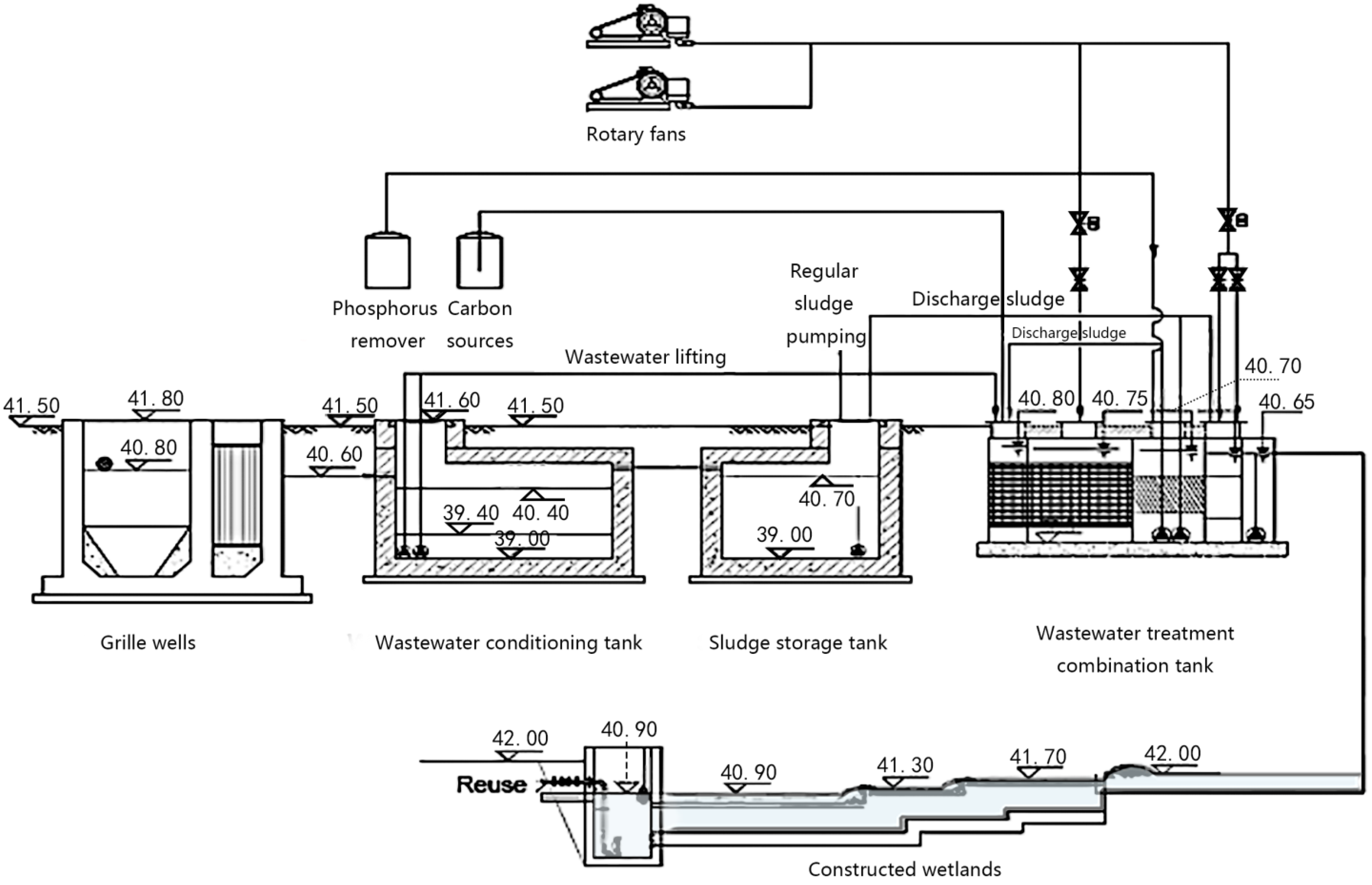
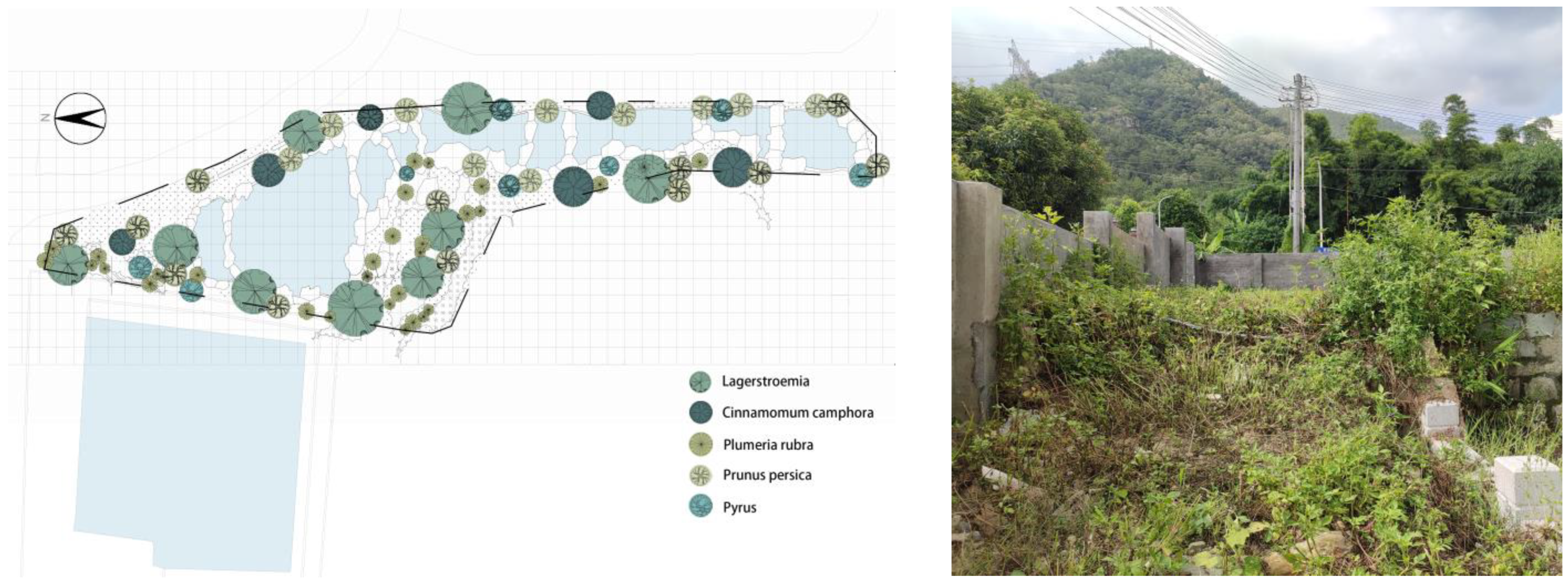
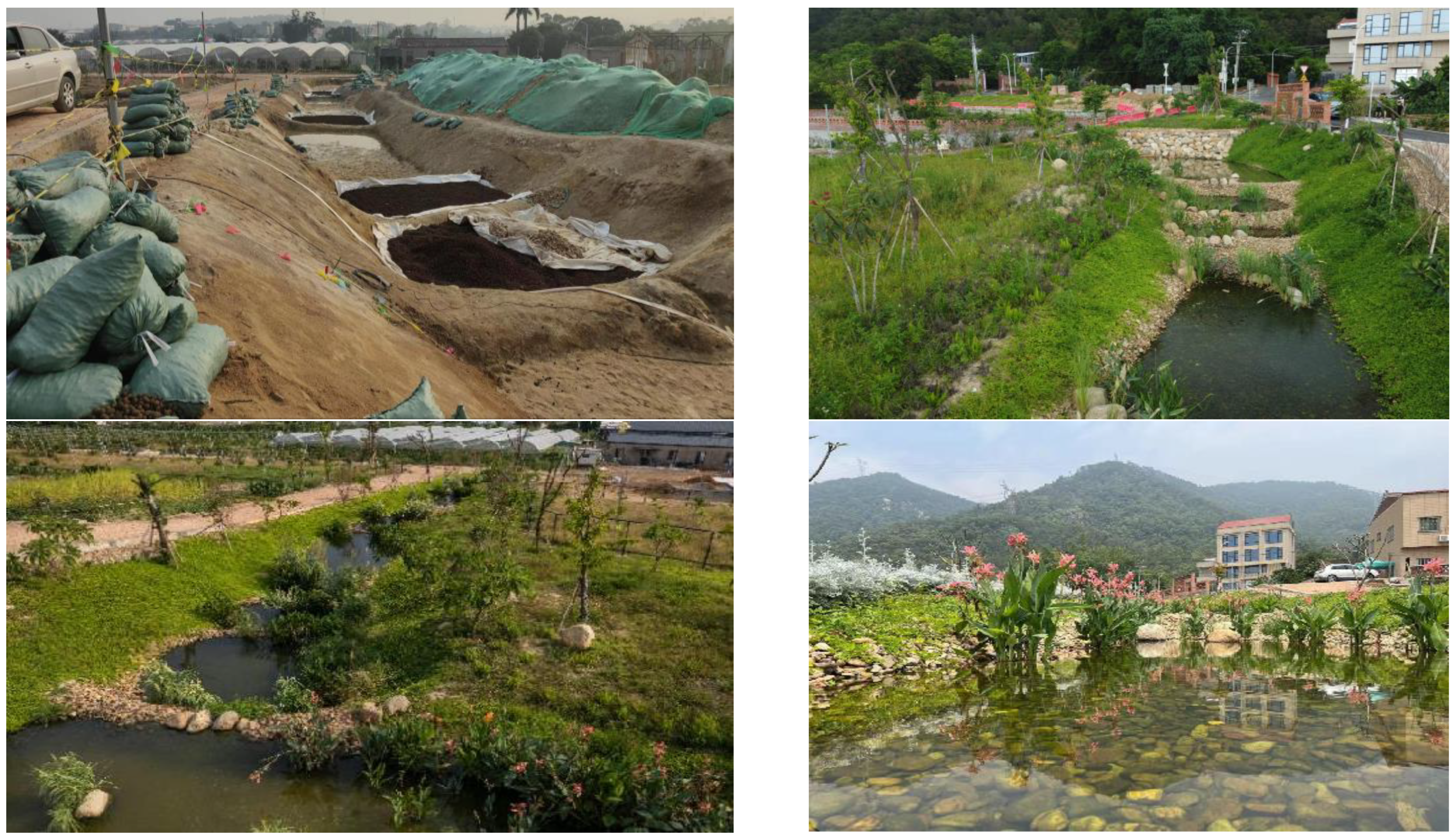
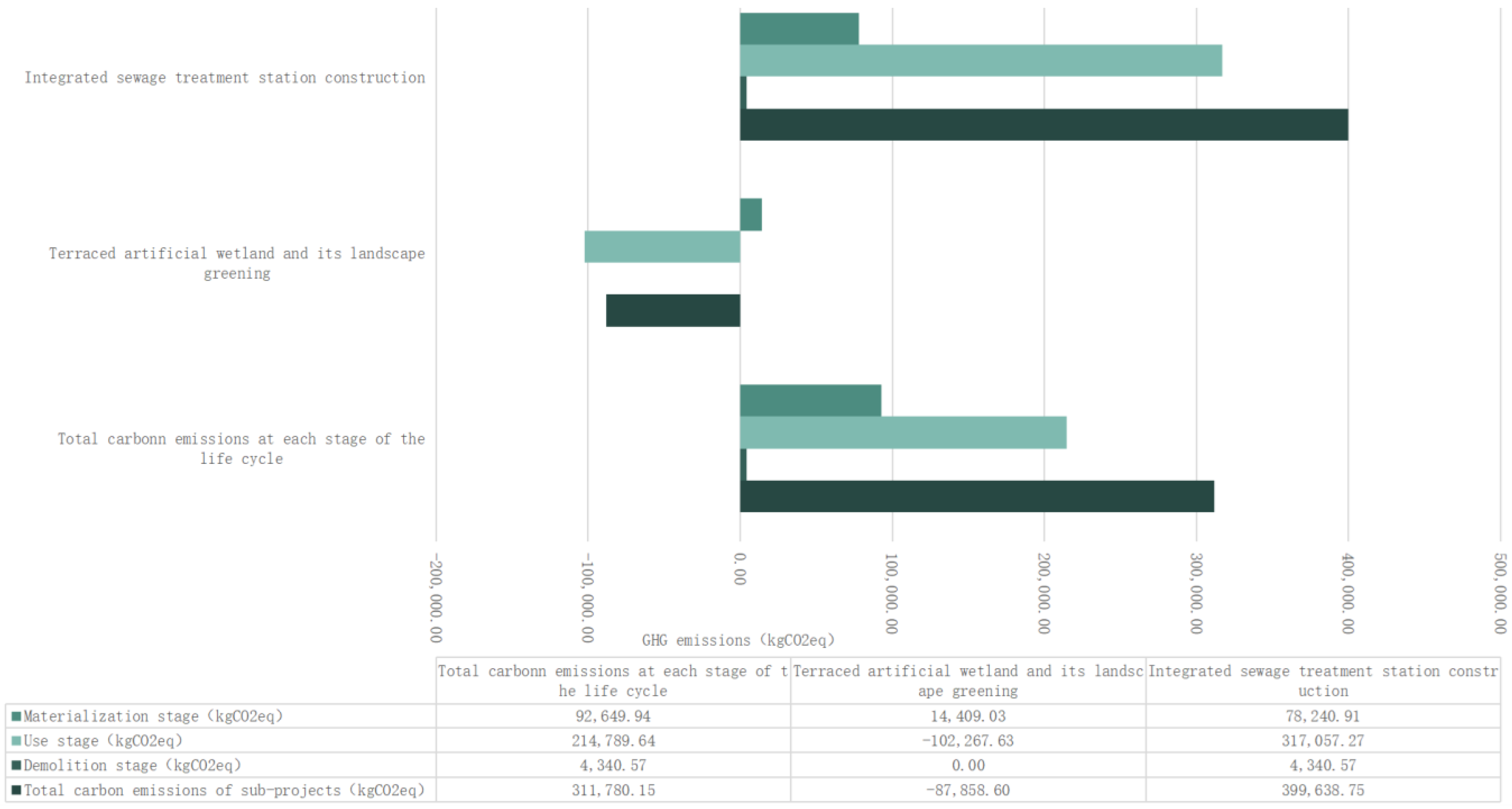
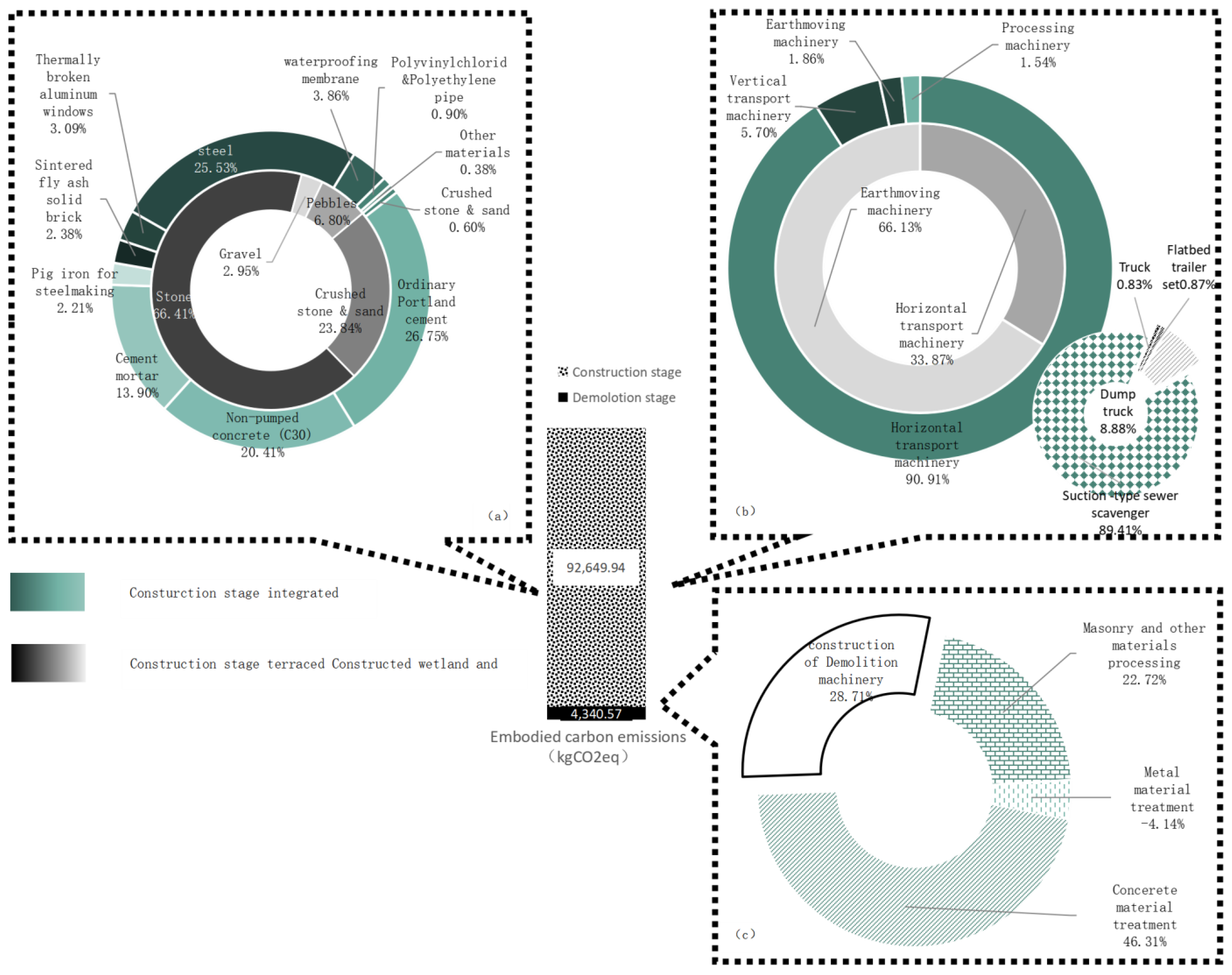

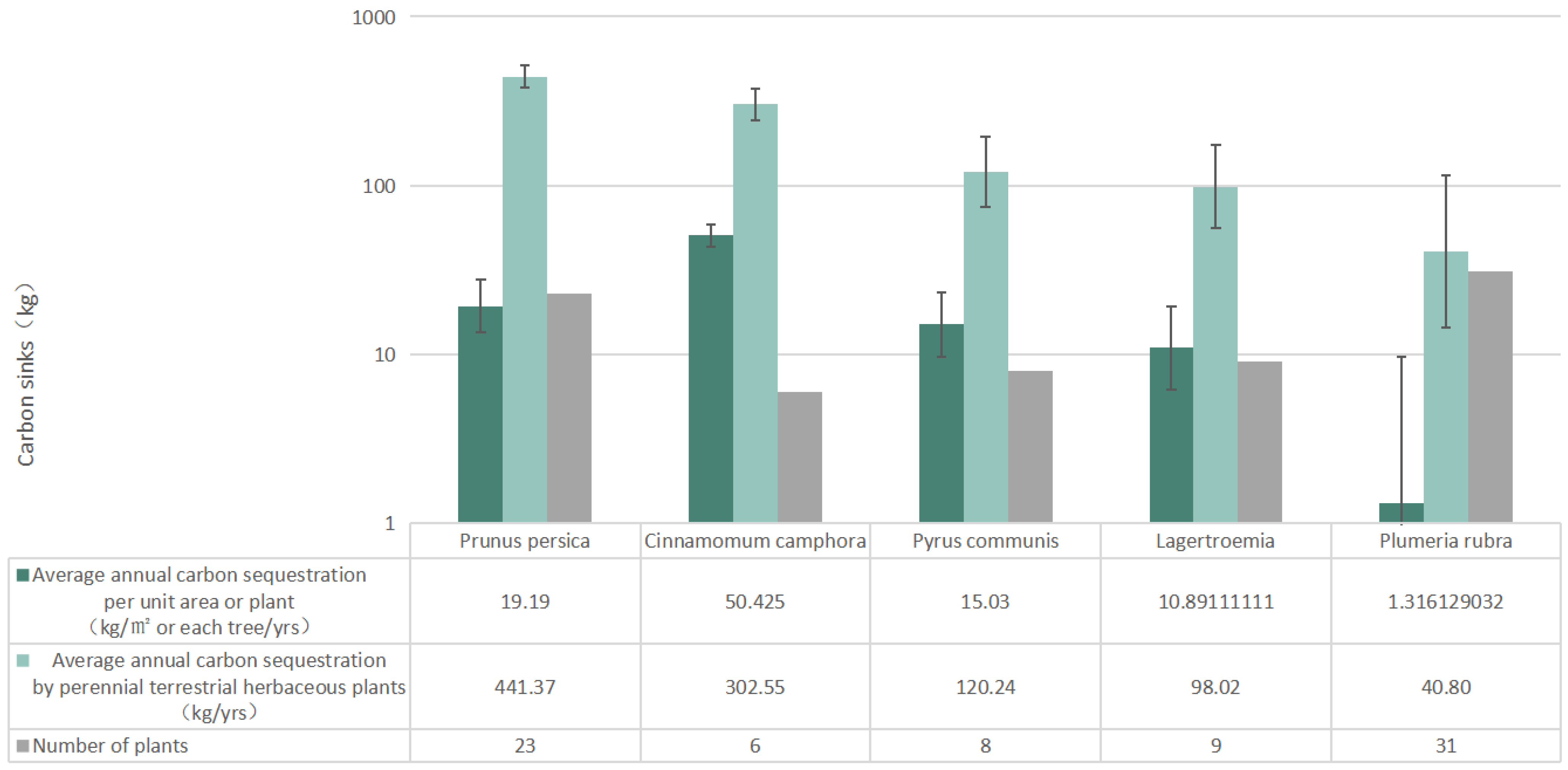
| Content | Name | Unit | GHG Emissions Factors (kgCO2eq/Unit) | GHG Emission Sources |
|---|---|---|---|---|
| Fossil fuel GHG emissions from construction materials | Stone | kgCO2eq/m3 | 3.170 | construction material production |
| Gravel | kgCO2eq/t | 2.755 | ||
| Crushed stone (d = 10 mm~30 mm) (“d” represents the diameter of sand particles.) | kgCO2eq/t | 2.180 | ||
| sand (f = 1.6 mm~3.0 mm) (“f” represents the diameter of sand particles.) | kgCO2eq/m3 | 2.510 | ||
| Pebbles | kgCO2eq/m3 | 3.075 | ||
| Cement of ordinary Portland type | kgCO2eq/t | 735.000 | ||
| Non-pumped concrete (C30) (“C30” represents the Chinese concrete grade used to indicate its strength level.) | kgCO2eq/m3 | 295.000 | ||
| Mortar of cement (1:2) | kgCO2eq/m3 | 531.520 | ||
| Mortar of cement (1:2.5) | kgCO2eq/m3 | 469.410 | ||
| Mortar of cement (1:3) | kgCO2eq/m3 | 393.650 | ||
| Glass made from temperate steel | kgCO2eq/m2 | 21.480 | ||
| Steelmaking pig iron | kgCO2eq/t | 1700.000 | ||
| Solid brick made from sintered fly ash | kgCO2eq/m3 | 134.000 | ||
| Pipes made of polyethylene | kgCO2eq/kg | 3.600 | ||
| Pipe made of polyvinyl chloride | kgCO2eq/kg | 7.930 | ||
| Tiles with porcelain facings | kgCO2eq/m2 | 0.730 | ||
| Strips made from cold-rolled steel | kgCO2eq/t | 2530.000 | ||
| The medium-section of hot-rolled carbon steel | kgCO2eq/t | 2365.000 | ||
| Small-section of hot-rolled carbon steel | kgCO2eq/t | 2310.000 | ||
| Rebar made from hot-rolled carbon steel | kgCO2eq/t | 2340.000 | ||
| Asphalt made from petroleum | kgCO2eq/kg | 0.285 | ||
| Membrane made of SBS for waterproofing | kgCO2eq/m2 | 12.950 | ||
| Foam board made of polystyrene | kgCO2eq/m2 | 2.370 | ||
| Polystyrene Foam Board | kgCO2eq/m3 | 5.020 | ||
| Aluminum windows with thermal breaks | kgCO2eq/m2 | 254.00 | ||
| GHG emissions from construction machinery derived from fossil fuels | Diesel | kgCO2eq/kg | 3.0959 | |
| Gasoline | kgCO2eq/kg | 2.9251 | ||
| Electricity | kgCO2eq/Kw·h | 0.8086 |
| Constructed Wetland Type | MCF | Scope |
|---|---|---|
| Surface-Flow Constructed wetland | 0.4 | 0.08–0.7 |
| Horizontal submerged Constructed wetland | 0.1 | 0.07–0.13 |
| Vertical submerged Constructed wetland | 0.01 | 0.04–0.016 |
| Types | Average Annual Carbon Storge Rate | Units |
|---|---|---|
| Evergreen broad-leaved forests | 4.2 | kg/m2/years |
| Deciduous broad-leaved forests | 5.0 | |
| Coniferous forest | 5.8 | |
| Bamboo category | 4.9 |
| Materials | Recovery Rate | Recovered GHG Emissions Factor (kgCO2eq/t) | Disposal GHG Emissions Factor (Landfill) (kgCO2eq/t) |
|---|---|---|---|
| Concrete | 0.55 | 1.1365 | 43.99 |
| Metal | 0.85 | −37.3124 | 37.82 |
| Rubble bricks | 0.1 | 4.2 | 3.7701 |
| Time Period | Wastewater Treatment Capacity (t/d) | COD | TN | Wastewater Treatment Agents | ||||
|---|---|---|---|---|---|---|---|---|
| Water Intake (mg/L) | out of the Water (mg/L) | Water Intake (mg/L) | out of the water (mg/L) | PAC (g/d) | PAM (kg/d) | NaClO (kg/d) | ||
| Before remodeling | 20 | 233.00 | 42.1 | 37.00 | 26.29 | 0.8 l | 0.02 | 0.59 |
| After remodeling | 20 | 233.00 | 50.00 | 37.00 | 20.79 | 0.8 l | 0.02 | 0.59 |
| Category | Content | Activity Level Data | Data Source | ||
|---|---|---|---|---|---|
| Wastewater Treatment Station | Wastewater treatment station construction | Cement (23,532.34 kg); cement mortar (18.48 m3); non-pumped concrete (44.72 m3); sand and gravel (213.7 t) (A total of 27.776 m³ of crushed stone was used, and the bulk density of crushed stone was taken as 1560 kg/m³ (Zhang Xiaocun. GHG emissions measurement method and comparative study of green building structure system [D]. (Harbin Institute of Technology, 2014.)); tempered glass (7.02 m2); iron (841.14 kg); fly-ash-aerated concrete block (11.49 m3); porcelain face tile (113.92 m2); aluminum alloy profile (318.83 m2); steel (6681.34 kg); petroleum asphalt (16.45 m2); asphalt self-adhesive membrane (100.12 m2); SBS waterproofing membrane (505.05 m2); extruded plastic sheet (0.93 m3) | List of Quantities for the Upgrading of Sanxiushan Rural Domestic Sewage Treatment Station in Wuxian Town | ||
| Infrastructure Renewal | PE pipe (104.42 kg) (The specifications used were: De50 (30.6 m), De75 (83.03 m), De90 (100.98 m), and De160 (10.2 m). According to the National Standard of Polyethylene (PE) Pipe for Water Supply (GB/T13663-2000), the density of PE pipe should be 1350–1550 kg/m2, and 1450 kg/m2 was used in this paper. For the convenience of calculation, the surface area of the pipe was calculated according to its nominal outer diameter.); PVC pipe (26.04 kg) (The specifications used were: De110 (34.541 m), De80 (3.06 m), De50 (16.32 m), and De32 (28.56 m). According to the National Standard for Rigid Polyvinyl Chloride (PVC-U) Pipe for Building Drainage (GB/T5836.1-2006),the PVC-U pipe density should be of 1350–1550 kg/m2, and this paper used 1450 kg/m2 in order to facilitate the calculation, according to the diameter of the middle of the socket (De) to calculate the surface area of the pipe.) | ||||
| Constructed wetland and its landscape greening | Constructed wetland construction | Gravel (40.568 m3); stone (1053.47 kg); natural sand (343.30 m3); pebbles (83.85 m3); Support steel tube (96.10 kg) | |||
| Trees | Lagerstroemia (9); Cinnamomum camphora (6); Plumeria rubra (31); Prunus persica (23); Pyrus (8) | ||||
| Shrubs | Green Bamboo | ||||
| Constructed wetland and planting of landscape greening plants | Perennial terrestrial herbs | Groundcover Plants | Hemerocallis fulva (4 m2); Iris tectorum (5 m2); Asparagus densiflorus (20 m2); Iris lactea (3 m2); African Agapanthus (15 m2); Tradescantia ohiensis (1 m2); Crocosmia crocosmiflora (4 m2); Carex (5 m2); Verbena bonariensis (3 m2); Salvia japonica (11 m2); Physostegia virginiana (1 m2); Symphyotrichum (1 m2); Echinacea purpurea (5 m2); Crossostephium Chinense (34 m2); Consolida ajacis (6 m2); Sedum lineare (308 m2); Axonopus compressus (230 m2); Canna indica (4 m2) | ||
| Vine Plants | Petunia hybrida (25 m2) | ||||
| Perennial aquatic vascular plants | Emerged plants | Cortaderia selloana (50 m2); Phragmites australis (16 m2); Iris ensata (5 m2); Pontederia cordata (6 m2); Thalia dealbata (4 m2) | |||
| submerged plants | Vallisneria natans (3 m2); Hydrilla verticillata (2 m2) | ||||
| floating plants | Nymphaea (2 m2) | ||||
| Category | Content | Detailed Information | Construction Stage | Usage Stage | Demolition Stage |
|---|---|---|---|---|---|
| Wastewater Treatment Station | Treatment station construction | Sewage treatment station construction, drainage pipe renewal, etc. | + | + | + |
| Artificial wetland with landscaped green space | Construction and renovation of terraced constructed wetlands | Increasing the area of terraced constructed wetlands, planting aquatic plants, etc. | + | − | Temporarily not considering the demolition stage |
| Increase greenery | Planting of trees, shrubs and lawns, etc. | + | − |
| Category | Content | Activity Level Data | Data Collection Methods |
|---|---|---|---|
| Before remodeling | |||
| Wastewater Treatment Station | Treatment of wastewater | 7300 m³/years | On-site research |
| Power consumption of treatment equipment | 7336.50 Kw/years | ||
| After remodeling | |||
| Wastewater Treatment Station | Treatment of wastewater | 7300 m³/years | On-site research |
| Power consumption of treatment equipment | 5358.20 Kw/years | ||
| Constructed wetland and landscape green space | Soil improvement | 1008 kg/years (urea) | List of Quantities for the Upgrading of Sanxiushan Rural Domestic Sewage Treatment Station in Wuxian Town |
| Water pump irrigation | 36 Kw/years | On-site research | |
| Substrate Type | N2O Emission Fluxes mg/m2/h | CH4 Emission Fluxes mg/m2/h |
|---|---|---|
| Gravel | 0.07–0.61 | 0.31–47.48 |
| Manganese Ore | 0.11–0.17 | 1.61 ± 2.39 |
| Activated alumina | 0.14–0.26 | 5.12–7.74 |
| Iron carbon micro-electrolysis filler + gravel | 0.25–0.33 | 0.23–0.35 |
| Iron carbon micro-electrolysis filler + zeolite | 0.20–0.26 | 0.16–0.26 |
| zeolite | 0.41–0.48 | 0.16–0.24 |
| Iron Ore | 0.20–0.37 | 18.58–28.74 |
| Biochar | 0.11–0.37 | 0.09–19.57 |
| Iron Ore + Biochar | 0.18–0.40 | 4.08–14.44 |
Disclaimer/Publisher’s Note: The statements, opinions and data contained in all publications are solely those of the individual author(s) and contributor(s) and not of MDPI and/or the editor(s). MDPI and/or the editor(s) disclaim responsibility for any injury to people or property resulting from any ideas, methods, instructions or products referred to in the content. |
© 2023 by the authors. Licensee MDPI, Basel, Switzerland. This article is an open access article distributed under the terms and conditions of the Creative Commons Attribution (CC BY) license (https://creativecommons.org/licenses/by/4.0/).
Share and Cite
Liu, X.; Zhang, H.; Yao, M.; Li, L.; Qin, Y. Assessment of Carbon Reduction Benefits of A/O-Gradient Constructed Wetland Renovation for Rural Wastewater Treatment in the Southeast Coastal Areas of China Based on Life Cycle Assessment: The Example of Xiamen Sanxiushan Village. Sustainability 2023, 15, 8094. https://doi.org/10.3390/su15108094
Liu X, Zhang H, Yao M, Li L, Qin Y. Assessment of Carbon Reduction Benefits of A/O-Gradient Constructed Wetland Renovation for Rural Wastewater Treatment in the Southeast Coastal Areas of China Based on Life Cycle Assessment: The Example of Xiamen Sanxiushan Village. Sustainability. 2023; 15(10):8094. https://doi.org/10.3390/su15108094
Chicago/Turabian StyleLiu, Xianpeng, Heng Zhang, Minfeng Yao, Li Li, and Yuchen Qin. 2023. "Assessment of Carbon Reduction Benefits of A/O-Gradient Constructed Wetland Renovation for Rural Wastewater Treatment in the Southeast Coastal Areas of China Based on Life Cycle Assessment: The Example of Xiamen Sanxiushan Village" Sustainability 15, no. 10: 8094. https://doi.org/10.3390/su15108094
APA StyleLiu, X., Zhang, H., Yao, M., Li, L., & Qin, Y. (2023). Assessment of Carbon Reduction Benefits of A/O-Gradient Constructed Wetland Renovation for Rural Wastewater Treatment in the Southeast Coastal Areas of China Based on Life Cycle Assessment: The Example of Xiamen Sanxiushan Village. Sustainability, 15(10), 8094. https://doi.org/10.3390/su15108094






